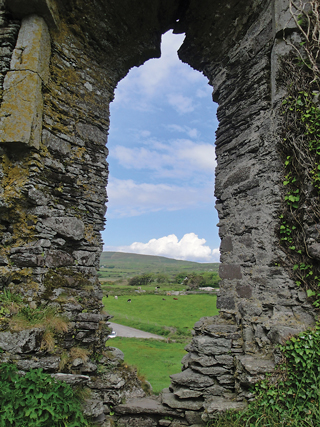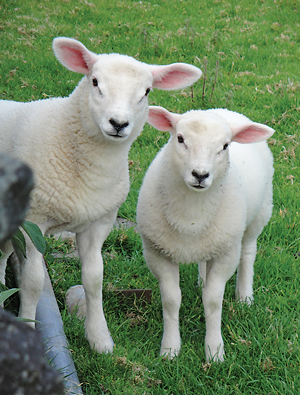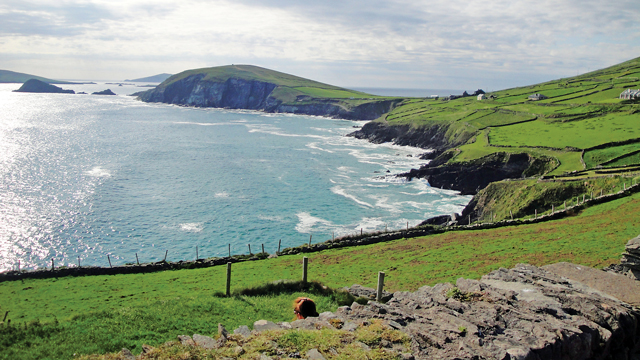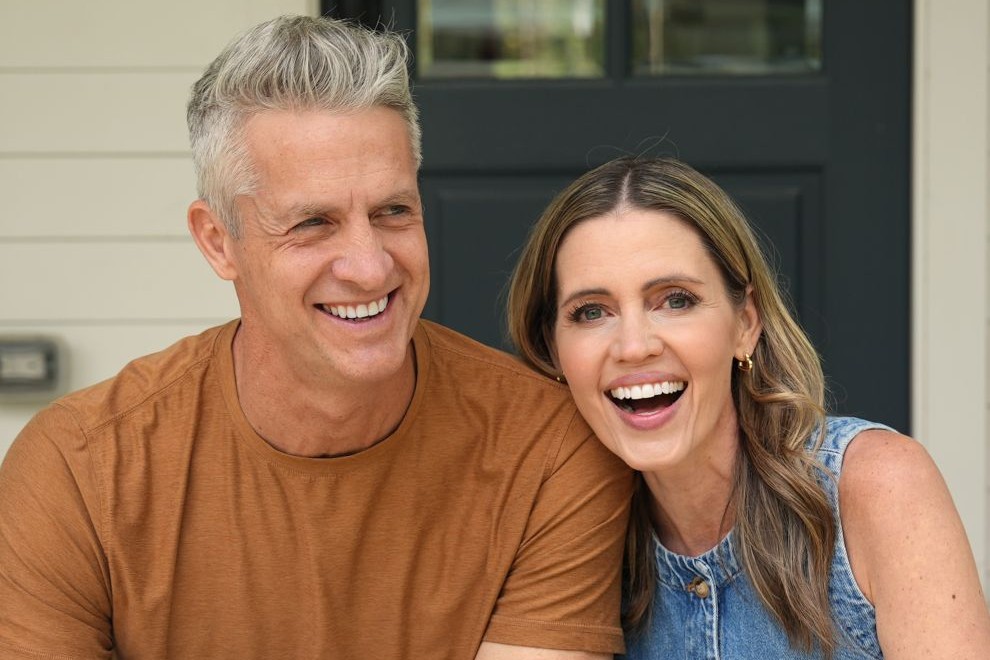It is the dream of many immigrants to bring their children back to see their country of origin one day. My great- grandmother came to the United States from Ireland when she was a teen. Her daughter and granddaughter (my mother) never got to make that trip. So my grandmother wanted me to see Valentia, the tiny windswept island off the West Coast of Ireland where her mother once lived. I made that trip earlier in my life, but it was important for me to fulfill that ancestral wish through another generation. I wanted to bring my first grandchild, Kat, who is fifteen, to Ireland.
Taking a teen on a trip can be tricky. In bucolic western Ireland, there are no malls or movie theaters. You can’t take Wi-Fi for granted, that’s for sure. Would she be bored? Would the absence of techno-entertainment cause serious withdrawal? Or would she experience the same wonder and joy over the landscape, the friendly people, the ancient ruins, and the musical language as I did when I first visited Ireland? I have three grandchildren, each completely different. But Kat has nurtured a love of green spaces, the ocean, horses, castles, and dragons. Of the three, this is the one with the Irish genes.
I knew from past trips, we would not be meeting any relatives. It would be enough to show her the places and share the family’s origin stories. I would also focus on her interests: a few nights at a sheep farm; an overnight stay in a castle; a stay at a horse farm; prehistoric ruins; beaches and forests; and places she could climb.
We flew into Shannon, where we would see the sights, then pick up an American friend who was joining us, and work our way westward to the ocean and Valentia Island. It was too early to check into our bed and breakfast, so we went to famous Bunratty Castle nearby and were the first visitors that morning. We had the whole castle to roam and explore. We crossed over the drawbridge above the remnants of a moat, lingered in a huge room where the lord of the castle would hold court and judge the affairs of the area, then entered the banquet hall, decorated with ancient tapestries that still share the lives and events of a people long since dead. The huge antlers of the extinct giant Irish elk, empty suits of armor, swords, pikes, and spears lined the walls. There were winding stone staircases built for dwarves and a creepy dungeon complete with chains on the lowest level. Kat was thrilled when no one stopped her from climbing all the way to the top of the castle and roaming the turrets, where she enjoyed a fantastic view of the surrounding countryside and the Shannon River.
That night, we went back to Bunratty for the medieval banquet. The great hall was filled with hundreds of people. Servers gave us a glass of mead (honey liqueur), which knocked me out. The food, despite having to eat it with our hands, was very good and the entertainment – a harpist, violinist, singers, and a ghost story skit – was charming. Since the banquet fare wasn’t to Kat’s liking (she’s an American teen after all), we went out to a pub, and she had an incredible grilled cheese sandwich made from local Kerrygold cheese, butter, and homemade bread, while we listened to local musicians jamming to what could be described as a Gaelic version of bluegrass.

The Irish are a very practical and frugal people. That night, it was forty degrees outside, and I gave our B&B owner, Dolores, a good laugh when I asked how to turn on the heat in our room. “Heat? It’s practically summer. If I did that, all the guests would be complaining of it being too warm.” Then she offered us each a hot water bottle for our beds. Kat, who did not know what a hot water bottle is, looked on in amazement. Dolores later made up for the lack of heat with a sumptuous Irish breakfast featuring incredible homemade pastries. Food in Ireland has suffered from some bad press, but is now quite good, thanks to a concerted national effort to improve tourism through culinary education and higher standards.
Exploring the next day, we passed through several small villages in the hills, and discovered Craggaunowen, a sixteenth century castle, and a restored prehistoric settlement known as a crannog. The crannogs are dwellings built for defense on man-made islands. Crannogs date back to about 500 B.C. and many were still in use until the seventeenth century. The castle built nearby had a tour guide to show you exactly how the castle was built, lived in, and utilized for defense. Kat was fascinated with the souterrains (secret underground tunnels) still in existence that allowed discreet escape from the crannog into the castle. The path from the crannog to the castle took us through the deep, old growth of an Irish forest. Huge trees covered in green velvety moss, rolling hillocks, fiddlehead and staghorn ferns, and wildflowers surrounded us in an organic cavern. I half-expected a hobbit to come running along the trail at any moment.
I wanted to give Kat an overnight stay in a real live-in castle, so our big splurge was Ballyseede Castle in Tralee. This is an impressive, elegant family-owned castle with evidence of the family still present. You have the feel of being an invited guest in someone’s (huge and extravagant) home. We watched two painted ponies and donkeys frolic and chase each other on the castle grounds as twilight descended. Kat and I launched our own private tour of the many floors, halls, and spooky areas of the castle. We fantasized about the men who once wore the elaborately fashioned suits of armor standing at attention and brandishing the swords mounted on the walls. More recent pictures of grand dames and gentlemen, with their bios, hung alongside heads of wild boar, elk, and stuffed birds. We had formal tea in the luxurious lounge with delicate, painted teacups, and individual pots, with crystal sugar.

Out back, the manicured gardens reached out to the deep woods where the Irish deer shyly watched us. The staff members are formal and polite and didn’t cringe – even when my granddaughter requested a burger and ketchup, of course.
The next day brought us closer to the ocean and our island destination. We were now in the West of Ireland, also called the Wild Atlantic Way because it is so remote and was never completely conquered by Great Britain. It’s where the rebels went to hide and the once-outlawed Gaelic language is still spoken. This is what I wanted Kat to experience.
Two of the most beloved spots in this area are the Dingle Peninsula and the Ring of Kerry. Both are land masses jutting out and almost surrounded by the sea. The air is exquisite. The land is an intense green. Stark stone cliffs stand hundreds of feet above the crashing white surf. The skies are all at once cloudy, misty, foggy, rain-bowed, and sun-showered. We stayed in Dingle on a sheep farm. The owner, Pat, welcomed us with her homemade brown bread. Pat’s husband gave us a treat by having his black and white border collie, Joe, round up the sheep in the field and bring them in so Kat could hold and pet a newborn lamb. Joe was magnificent as he flew around the field driving the sheep towards us. In minutes, he had the whole flock inside a pen and lay down by his master’s feet, panting and pleased with himself.
You can make a circuit of the Dingle Peninsula by taking the Slea Head Drive. It’s only thirty miles long, but so rich with history, archaeological treasures, beaches, and fantastic views that you can easily spend several days here. The landscape has several world-famous sites like the Gallarus Oratory, a stone chapel built without mortar in the shape of an overturned boat where monks lived their solitary lives a thousand years ago. The stones are placed so perfectly that the oratory (or chapel) is still watertight after all these centuries. The one window and door align with the setting sun in the west.
We roamed the grounds of Dunbeg Stone Fort, a prehistoric stone-ring fort that still stands

against the weather and the sea, built on a spectacular cliff. It’s carbon-dated to 580 B.C. Earthen works are still visible with tunnels and inner stone dwellings. The ancient past seems fully present here. Fear must have been the motivation to build this fort in such a dangerous location. One slip and you are into the sea. Across the road, on a steep hillside, are numerous beehive huts and other stone dwellings occupied from the late Bronze Age into medieval times. Many are on private property, but can be toured after paying a small fee. There’s no need for Wi-Fi here. Kat delighted in running down the long path from the road to the fort and looking over the edge of the cliff to the crashing surf about two hundred feet below.
If you go, take the time to follow the signs for Kilmalkedar Church and graveyard. The church is a twelfth century Romanesque building on the site of a much older monastic settlement, where Brendan the Navigator preached. What is exciting about many treasures like this in Ireland, is their accessibility. Frequently, there are no gates, no fees, and no fences. You can actually touch a tall grave stone with Ogham writing (an ancient Irish alphabet used before Latin) at the church and a stone sundial marked in segments corresponding to the divisions of the monastic day. Inside the church is an ancient alphabet stone with both sixth century (and earlier) Latin writing.
One of the stops we both loved on the drive was the Celtic and Prehistoric Museum in Ventry. This is a privately owned treasure trove of antiquities and fossils. Kat was fascinated by the skeleton of a 12-foot tall cave bear that looms over you with claws outstretched, and what is claimed to be the largest intact wooly mammoth skull with tusks in the world. They also have a fantastic collection of Celtic and Viking grave jewelry, bronze pieces, and lots of interesting items to see or buy.
Then we drove on to Clough Beach, which is well worth a stop for its fantastic geometric stone formations, slashing sideways along the shore. There are clay deposits used by local potters, as well as fossils visible in the rocks. Kat climbed up the rock cliffs while I watched, biting my fingernails and wondering how I would explain this to her parents if something went wrong.

We stopped at Ballyferriter for dinner in a dark pub, and listened to lads at the bar share wife jokes as we ate potato and leek soup and brown bread. Then we watched five local girls with their fiddles play rousing jigs and soulful airs. We felt completely at home everywhere we stopped in Ireland. In town, we bought Murphy’s homemade ice cream made with the same unbelievably rich cream found in Kerrygold butter and cheese.
The next day, we left our sheep farm and went south to the Ring of Kerry. Finally, we were in sight of Cahirciveen, the town closest to my great-grandmother’s island, Valentia. Kat noted that it seemed all the businesses, grocers, and restaurants in Cahirciveen bore my great-grandmother’s name, O’Shea. My great-grandmother had always sworn there were palm trees and tropical plants on Valentia, and no one believed her. But it’s true, the Gulf Stream hits it just right, warming it enough that tropical plants and palm trees do thrive there.
We chatted with a woman who ran a local B&B. “Where in the states are you from?” she asked. I explained that while I lived in Virginia, I had grown up in Bridgeport, Connecticut, the town my great-grandmother had emigrated to. She said, “Oh, of course I know Bridgeport. That’s where they all went from here.” She went on to share tidbits about Bridgeport that I didn’t even know. It was a weird feeling that someone so far away knew so much about my birthplace in the United States, demonstrating how connected we all are.
On Valentia, I showed Kat the little cottages, whitewashed with lime, just as my grandmother whitewashed the stone foundation of her house in Connecticut.We saw the quaint church where my great-grandmother was married and where her two Ireland-born babies were baptized. There were fishing boats in the harbor where two of my great-uncles went out to sea and never came back, their bodies washed up and identified by the family patterns on their hand-knit sweaters. My grandmother said that her mother told her about watching the laying of the first transatlantic cable across the island in 1857. We saw the farms, the cows, sheep, and horses, the fields, and gardens that made up the daily landscape of our ancestors’ lives.
Other stories came flooding back. My great-grandmother’s husband was already working in the States, and had sent money for passage across the ocean for her and their two children. But her mother did not want her to have to travel in steerage, the bottom-most part of the boat, where the poorest people were packed in and often fell seriously ill during the trip. So against her husband’s wishes, my great-grandmother took the family cow to market and sold it to buy her daughter a better berth. Once in the United States, she forbade her children from speaking Gaelic, advising them, “You are now in America, speak the common language.” These strong women had many lessons to share.
I had worried about Kat being bored. She was not. The West of Ireland is a different world – charming in its simplicity, still family-friendly, welcoming, and safe. It’s a wonderful place to visit with your family while it is still accessible and unspoiled. And if you like Game of Thrones, Lord of the Rings, and Outlander (to throw in a few contemporary pop culture references), you will treasure the West of Ireland for completely different reasons. For my granddaughter and me, our trip to the region forged an understanding and a bond that would not have been established anywhere else.
photos by Diane York





